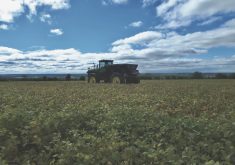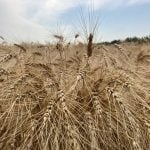Some growers opt for their region’s top crops. It only makes sense, after all, to reduce your risks by effectively pooling everyone’s combined experience. Others, though, look for ways to be different. They want to boost their margins, and they feel they need to be entrepreneurial if they’re going to move the yardsticks.
For those producers, farming means searching for something that may require a little added effort on management or marketing.
But even within that group, some choices are more popular, like identity preserved (IP) soybeans, edible beans and winter canola, each with its strengths and drawbacks, including contract premiums, longer rotations and soil health benefits.
Read Also

Could crop sharing be a viable option for your farm?
Crop sharing could be a good option for young and beginning farmers.
Buckwheat would rarely be first on anyone’s list. Like flax or ginseng, the crop is small compared to corn, soybeans and wheat with roughly 35,000 acres grown across the country. According to the federal government’s Census of Agriculture in 2016, Ontario produced 10,622 acres of buckwheat, an increase of 68 per cent over 2011’s reported production. Although Manitoba was Canada’s leading producer 30 years ago, production there dropped to roughly 5,600 acres in 2017.
Now, though, we’re seeing a change in demand. In the past, most Canadian buckwheat went to Japan, where millers ground it into flour for soba noodles. More recently, though, demand for healthier diets and gluten-free has kept more buckwheat closer to home, especially in the eastern half of the continent, encouraging production in Ontario and Quebec.
There are also numerous challenges with trans-Pacific shipping right now, especially with containers at a premium. That can cause delays which in turn can adversely affect the quality of the flour milled from buckwheat grains. If stored for too long for the Japanese market, the flavour and colour of the soba noodles can be diminished.
The other factor discouraging Asian demand comes from China, one of the world’s largest buckwheat producers alongside Russia, Brazil, Poland, France, Japan, South Africa and the U.S. Since China sells the grain at roughly a third of the price of North American production, it’s a strong competitor in Japan, despite its poorer quality and blending of foreign material.
Here at home

For Henry Denotter, growing buckwheat grew into a six-year odyssey after he began looking for a crop to follow winter wheat, trying to get a return like double-cropped soybeans following a cereal.
“We planted no till with an air seeder mid-July after wheat,” says Denotter, who farms near Kingsville, Ont. “The first two years, we spread the straw cut from the wheat at 10 inches. It worked but the buckwheat was slow coming up and we had a lot of trash to re-combine at harvest.”
Denotter then skipped planting buckwheat because it was a dry summer. That proved to be a mistake as it rained early that fall and would have been sufficient to make a crop.
Present protocol
The practice Denotter has found most successful involves cutting wheat at two to four inches in a windrow, then baling and removing the straw. Denotter likes to spread the chaff out from under the windrow as best he can. Then he sprays a burn-down using either glyphosate or glufosinate, which he says works well in the midsummer heat.
“Then we plant with the air seeder at no-till rates that vary depending on seed size and germination of the seed but about 50 lbs. per acre,” he adds. “If there’s some moisture, the seedlings will be up in four days with the first flowers in 20 days.”
According to a specialty crop growers guide from the Ontario Ministry of Agriculture, Food and Rural Affairs (OMAFRA), Denotter’s numbers are in line with ministry rates of 50 to 65 kg/ha (44.6 to 58 lbs. per acre). Planting depth is recommended at roughly 1.5 to 2.5 inches with row spacing at 7 to 7.5 inches.
The OMAFRA guide also recommends planting as a midsummer crop as this helps emerging seedlings avoid frost events in spring or fall. Optimum soil temperatures at planting are 5 C or higher with the seed germinating at 7 C, and an optimal growing temperature of 20 C.

Currently, there only five varieties registered for production by the Canadian Food Inspection Agency (CFIA), including AC Manitoba, Koban, Koto, Mancan and Manor. The OMAFRA guide states there have been no variety trials conducted in Ontario, but keep in mind the document was last updated in 2012.
Aside from the opportunity for marketing the grain and its simultaneous use as a cover crop, Denotter likes how buckwheat flowers attract bees.
“It’s definitely a pollinator-friendly crop and can easily flower for six weeks,” he says, adding that buckwheat honey is a premium product. “There aren’t a lot of flowers out in August so the bees will stay with the field, and I do put signage up that it’s a pollinator-friendly crop.”
Pre-harvest
After roughly 10 weeks, Denotter either desiccates the crop or waits for a killing frost. Combine with care and cut it low, he advises. Any wheat straw that’s re-cut will be in the sample.
Once harvested, a grower is left with a hard black nut-like shell with bright white powder inside. As a broadleaf plant, it’s not seen as a grain-and-straw crop while the seed says it’s a nut.
“There are also moisture standards,” says Denotter. “Markets are for bird feed, as cover seed, for milling and pet food filler. It’s not an expensive product except if you want to buy good seed.”
Growers new to the crop should also pay attention to where the crop’s planted because there’s likely to be volunteer growth for a year or two. Timely straw removal and field conditions were the biggest challenges affecting Denotter with his crop in 2021.
“I usually plant 150 to 200 acres but this year I have 50,” he says. “It was planted late but there are still benefits if it doesn’t yield. The dollars you get from the straw can go back on the field in a controlled fertilizer application.”
Aside from the marketing end of production — and the potential revenue to be derived — the longer-term benefits to soil health and the attraction to bees are two important positives Denotter cites for venturing into the crop.
Researchers with Agriculture and Agri-Food Canada (AAFC) in Charlottetown, PEI and Agassiz, B.C., are also studying the use of buckwheat as a root-zone repellant for various species of wireworm. Growers on P.E.I. are using it as a rotational or cover crop in potatoes and have seen reductions in wireworm numbers, while researchers are testing buckwheat straw in horticultural crops like cucumber and radish. Although the initial studies are complete, researchers are hoping to attract funding for continued work.
For more information:
















